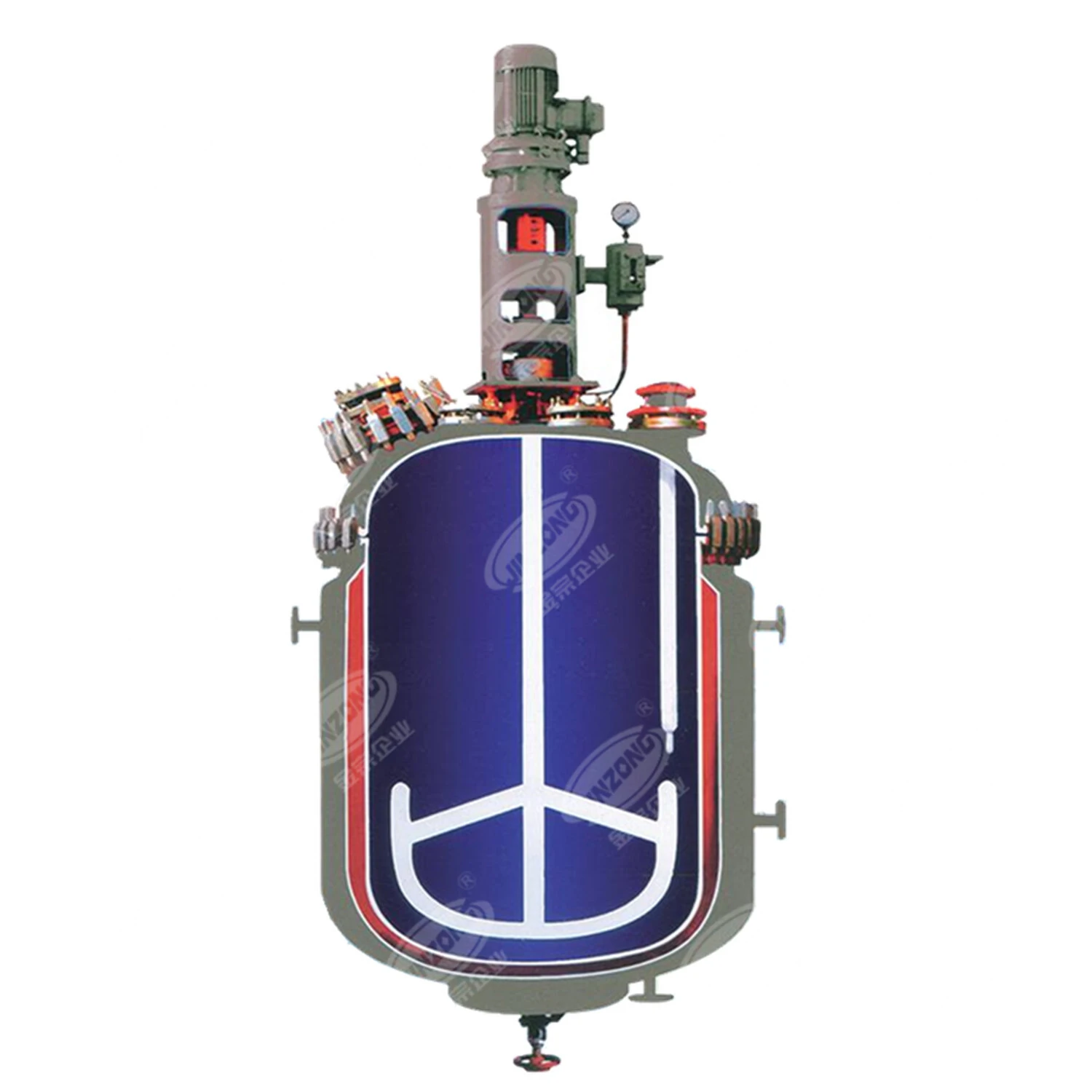Jinzong Machinery | Cosmetic Machinery & Chemical Machinery Manufacturers
Glass lined reactor Enamel reaction kettle
Our Glass lined reactor Enamel reaction kettle are all fired with a specific specification electric furnace. Enamel/glass enameled equipment has smooth surface, wear resistance, heat resistance, easy washing, non-polluting materials, low price, and not easy porcelain.
Enamels and enamels are only different in name, and there is actually no essential difference. Specially speaking, enamels are low-temperature enamels(690-780 °C), and enamels are high-temperature enamels(880-1050 °C). The melting temperature of the steel plate is 1300 °C.
*DEFINITION OF Glass lined reactor Enamel reaction kettle:
The enamel/enamelled glass reaction kettle(reaction tank) is a chemical equipment that enamels glass enamels containing high silicon dioxide and is lined on the inner surface of a steel container, and is then evenly bonded to the metal surface by burning at high temperatures. Therefore, the enamel reaction kettle has the dual advantages of glass stability and metal strength, and is an excellent corrosion resistant chemical equipment. The enamel reaction kettle(enamel reaction tank) is widely used for reaction, evaporation, concentration and synthesis in industrial production and scientific research such as chemical industry, medicine, dyes, pesticides, organic synthesis, petroleum, food manufacturing and defense industry. , extraction, polymerization, saponification, mineralization, chlorination, nitrification, etc. to replace expensive stainless steel and non-ferrous metals.
Reactor kettles, also known as reaction tanks, distillation tanks, water bath kettles, neutralization kettles, dissolution kettles, condensation kettles, and many other names are named based on the chemical reactions of their own products.
*MAIN COMPOSITION of Glass lined reactor Enamel reaction kettle:
The glass lined reactor enamel reaction kettle heating equipment is mainly composed of tank body, insulation material and accessories. The tank body includes inner cylinder, outer cylinder, jacket and supporting foot, etc. Rock wool filling is used as insulation layer between inner cylinder and outer cylinder, jacket form is integrate jacket.
The accessories mainly include sanitary manhole, mirror, light, material and liquid inlet and outlet pipe, thermometer, pressure gauge, etc..
*Glass lined reactor Enamel reaction kettle performances and features:
◪ Voltage resistance: the glass lined has very good insulating property. working area does not conduct when testing with 20KV high frequency voltage.
◪ Corrosion proof: Glass-lined reactors are highly resistant to corrosion from acids, alkalis, and other aggressive chemicals. This is because the glass lining acts as a barrier between the corrosive material and the metal of the vessel.organic or inorganic acid, organic solvent and weak alkaline corrosion can be endured except hydrofluoric acid, media containing fluorine ion, oil of vitriol and alkali with their denisty over 30% and temperature higher than 180°C;
◪ Thermal Shock Resistance: Glass-lined reactors can withstand sudden changes in temperature without cracking or breaking. This is because the glass lining has a low coefficient of thermal expansion, which means it expands and contracts at a similar rate to the metal substrate.
Choosing the right glass-lined reactor for your specific application is an important decision that requires careful consideration of several factors. Here are some key factors to consider when choosing a glass-lined reactor:
Cost: Reactor cost should be compared with the benefits it offers for a specific process. A higher-quality reactor may be more expensive at first but has lower maintenance costs over time.
Size: The size of the reactor should be chosen based on the volume of material to be processed as well as the batch or continuous processing requirements. Consideration should also be given to the available space in the facility where the reactor will be located.
Agitation: The level of agitation required in the reactor should be considered, as this will affect the choice of agitator and motor required. Different types of agitators can be used depending on the process requirements, including anchor, paddle, turbine, and propeller.
Pressure and temperature: Reactor pressure and temperature: The reactor's maximum pressure and temperature should be considered. There are a variety of pressures and temperatures that glass-lined reactors can handle, but it is important to select a vessel that matches the specific process requirements.
Glass-lined reactors can be selected based on these factors, ensuring optimal performance and efficiency for your specific application. To ensure the best selection is made based on the process and application, it is always recommended to consult an reactor manufacturer.
*Glass lined reactor Enamel reaction kettle:
Glass-lined reactor is widely used in reaction, evaporation, concertration, composition, extraction, saponification, mineralization, chlorination, nitration etc. Of chemical, pharmaceutical, dye, pesticide, organic synthesis, petroleum, food additives, defense industry and scientific research. Corrosion resistance: It resists all kinds of glass lined reactor thickness of mediums like inorganic acid, organic acid, organic solvent and weak base etc. But it isn't suitable for strong base, hydrofluoric acid, fluorion medium, phosphoric acid whose temperature is over 180 degree and glass lined reactor glass thickness is over 30% etc.
Tel: +86-758-3623881
E-mail: sales@jinzong.com.cn
Fax: +86-758-3623880
Address: NO.3 Kangtai St., Hi-tech Dist., Zhaoqing City, Guangdong Province, China(526238)

